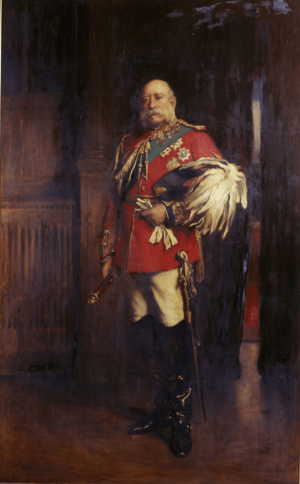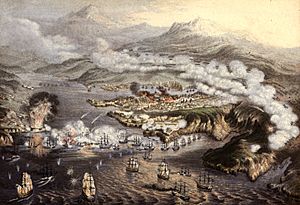77th (East Middlesex) Regiment of Foot facts for kids
Quick facts for kids 77th (East Middlesex) Regiment of Foot |
|
|---|---|
| Active | 1787–1881 |
| Country | |
| Branch | |
| Type | Line Infantry |
| Role | Light Infantry |
| Size | One battalion |
| Garrison/HQ | Hounslow Barracks |
| Nickname(s) | The Pot Hooks |
| Colors | Yellow facings |
| Engagements | Third Anglo-Mysore War Fourth Anglo-Mysore War Polygar Wars Napoleonic Wars Crimean War Indian Rebellion |
The 77th (East Middlesex) Regiment of Foot was a special group of soldiers in the British Army. They were like a team of "line infantry," meaning they fought in rows. This regiment was started in 1787.
Later, in 1881, the 77th Regiment joined with another group, the 57th (West Middlesex) Regiment of Foot. They formed a new, bigger regiment called the Duke of Cambridge's Own (Middlesex Regiment). This change happened because of new army rules called the Childers Reforms.
Contents
History of the 77th Regiment

How the Regiment Started
The 77th Regiment was first created in October 1787. It was called the 77th (Hindoostan) Regiment of Foot. General James Marsh started it because there were worries about a war with France. The soldiers were meant to serve in India.
The regiment first gathered in Dover, England, in early 1788. They arrived in India in August 1788. Their costs were paid by the British East India Company.
They fought in several important battles in India. These included the siege of Seringapatam in 1792. This was part of the Third Anglo-Mysore War. They also helped capture Dutch areas in Ceylon in 1795.
The regiment also fought in the Battle of Seedaseer in 1799. They were part of the attack group at the siege of Seringapatam in April 1799. This was during the Fourth Anglo-Mysore War. They also took part in smaller fights during the Polygar Wars in 1801. After many years, the regiment left India to return to England in February 1807.
On their way home, one of their ships, the Ganges, started leaking near the Cape of Good Hope. It sank, but luckily, another ship, the St Vincent, rescued everyone. All 203 or 209 people, including the soldiers, were saved.
Fighting in the Napoleonic Wars
In 1807, the regiment got a new name: the 77th (East Middlesex) Regiment of Foot. They took part in a difficult campaign called the Walcheren Campaign in 1809.
In 1810, they were allowed to wear special feathers and a motto. This was to celebrate their 20 years of service in India. In June 1811, they went to Spain to fight in the Peninsular War.
They fought bravely in several battles there. These included the Battle of El Bodón in September 1811. They also helped in the siege of Ciudad Rodrigo in January 1812. Another big fight was the siege of Badajoz in March 1812. Their last battle in this war was the Battle of Bayonne in April 1814. The regiment finally returned home in August 1814.
The Victorian Era Battles
In February 1824, the regiment went to Jamaica. Many soldiers got sick with fever there. They returned home in June 1834. Over the next few years, they served in different places. These included Malta (1837), Corfu (1842), and again in Jamaica (1843). They also went to Halifax in Nova Scotia (1846). They came back to England in May 1848.
In March 1854, they sailed to Malta and then to Scutari. They played a big part in the Crimean War. They fought in the Battle of Alma in September 1854. They also fought in the Battle of Inkerman in November 1854. A long and tough fight was the siege of Sevastopol in winter 1854.
During this war, two brave soldiers from the regiment received the Victoria Cross. This is a very special award for extreme bravery. They were Sergeant John Park and Private Alexander Wright. The regiment returned home in July 1856.
In June 1857, the regiment went to New South Wales. Then, in April 1858, they sailed to India. They helped put down the Indian Rebellion. They finally came home again in April 1870.
In June 1876, the regiment got a new, longer name: 77th (the East Middlesex) Regiment of Foot (The Duke of Cambridge's Own). From December 1876, they were allowed to use special symbols of Prince George, Duke of Cambridge on their flags and badges. In August 1880, they went to India one more time.
In the 1870s, the British Army made big changes. These were called the Cardwell Reforms. Smaller regiments were linked together. The 77th Regiment was linked with the 57th (West Middlesex) Regiment of Foot. They shared a training base at Hounslow Barracks.
Finally, on July 1, 1881, the Childers Reforms came into effect. The 77th Regiment officially joined with the 57th Regiment. They formed the new Duke of Cambridge's Own (Middlesex Regiment).
Battle Honours
These are the special battles the regiment fought bravely in:
- Fourth Anglo-Mysore War: Seringapatam
- Peninsular War: Ciudad Rodrigo, Badajoz, Peninsula
- Crimean War: Alma, Inkerman, Sevastopol
Victoria Cross Recipients
These soldiers from the 77th Regiment received the Victoria Cross for their amazing bravery:
- Sergeant John Park, during the Crimean War (April 19, 1855)
- Private Alexander Wright, during the Crimean War (March 22, 1855 and April 19, 1855)


